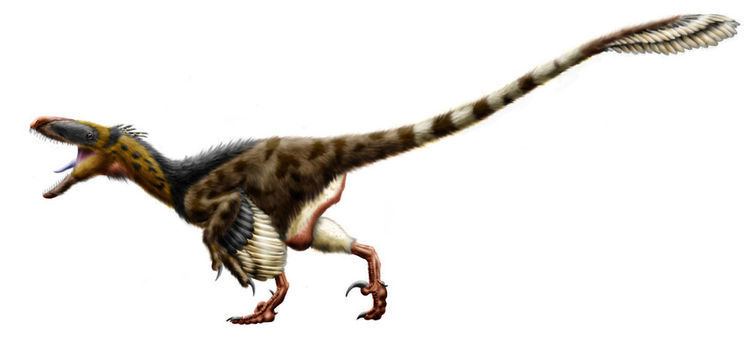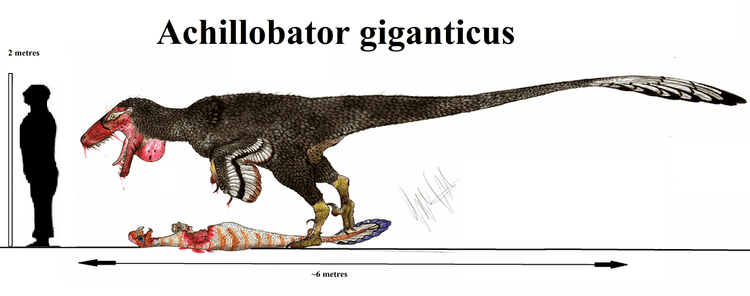Kingdom Animalia Order Saurischia Family †Dromaeosauridae Scientific name Achillobator Higher classification Dromaeosaurinae | Clade Dinosauria Suborder Theropoda Clade †Eudromaeosauria Phylum Chordata Rank Genus | |
 | ||
Similar Dinosaur, Dromaeosauridae, Adasaurus, Theropods, Austroraptor | ||
Ppba smilodon vs achillobator
Achillobator (/əˌkɪləˈbaɪtɔːr/ a-KILL-ə-BAY-tohr) is a dromaeosaurid theropod dinosaur that lived roughly 98 to 83 million years ago during the Late Cretaceous in what is now Mongolia, in Asia. It was among the largest dromaeosaurs; the holotype and only known individual of Achillobator is estimated at 5 to 6 m (16.4 to 19.7 ft) long. Achillobator was a moderately-built, ground-dwelling, bipedal carnivore. It would have been an active predator, hunting with the enlarged, sickle-shaped claw on the second toe.
Contents
- Ppba smilodon vs achillobator
- Daniel s dinosaur world achillobator
- Discovery and species
- Chimera hypothesis
- Classification
- Distinguishing anatomical features
- Provenance and occurrence
- Fauna and habitat
- References

Daniel s dinosaur world achillobator
Discovery and species

Fossils of Achillobator were first discovered during a Mongolian and Russian field expedition, and collected by Burkhant in 1989, but the specimen was not described and named until 1999, by Mongolian paleontologist Altangerel Perle, and American paleontologists Mark Norell and Jim Clark, although the description was not complete and was actually published without the knowledge of the latter two paleontologists.

The fossils of the type specimen of Achillobator, FR.MNUFR 15, were found associated but mostly disarticulated, and include a left maxilla with teeth, two cervical vertebrae, two dorsal vertebrae, rib fragments, seven caudal vertebrae, a scapula and coracoid, a pelvis with a right ilium, pubis and ischium, a radius, an incomplete manus, a left femur and tibia, and an incomplete pes. Smith at al. (2012) noted that this genus represents the second largest of the known dromaeosaurid taxa with a tibial length of 490 mm. Its femur, which is 3% longer than the tibia, a rare trait in Dromaeosaurs, measures 505 mm in length. Estimates suggest that Achillobator weighed 350 kg (771.6 lb) at most. The teeth are serrated and recurved, and the posterior serrations are slightly larger than the anterior serrations.

The genus name Achillobator means 'Achilles hero' and is derived from Achilles, a famous ancient Greek warrior who fought in the Trojan War, and the Mongolian word baatar, anciently bagatur, which means 'hero'. The generic name refers to the large Achilles tendon that connects to the sickle claw on the foot, which was the major combat weapon of dromaeosaurids. The specific name giganticus, is derived from Greek word gigantas (γίγαντας) meaning 'giant', which is in reference to Achillobator's size, which exceeds that of most other dromaeosaurids.
Chimera hypothesis
The pelvis of Achillobator seems to show plesiomorphic ("primitive") saurischian characteristics compared to other dromaeosaurids. For instance, the pubis is aligned vertically and has a large pubic boot (a wide expansion at the end), unlike most other dromaeosaurids, where there is a much smaller boot, if any, and the pubis points backwards in the same direction as the ischium (a condition called opisthopuby, which is also seen in the unrelated therizinosaurs and ornithischians, as well as in birds).
The above differences and others led Burnham et al. (2000) to suggest that Achillobator represents a paleontological chimera. However, other studies have attempted to refute this, noting that many pieces were found to be semi-articulated, all of the elements are the same color and preservation, and that Achillobator routinely comes out as a dromaeosaurid in cladistic analyses, even taking into account the differences.
Classification
Achillobator is a dromaeosaurid, a family of dinosaurs currently thought to be very closely related to birds. While the relationship of dromaeosaurids to other theropods (including birds) is relatively well-understood, the phylogeny within the family itself is not. The more recent phylogenetic analyses, conducted by Longrich and Currie (2009) and Senter et al. (2012) show that Achillobator is a member of the subfamily Dromaeosaurinae, most closely related to North American forms like Utahraptor and Dromaeosaurus. Deinonychus and Velociraptor are also dromaeosaurids, but appear to represent a different branch of the family.
Distinguishing anatomical features
A diagnosis is a statement of the anatomical features of an organism (or group) that collectively distinguish it from all other organisms. Some, but not all, of the features in a diagnosis are also autapomorphies. An autapomorphy is a distinctive anatomical feature that is unique to a given organism or group.
According to the revised diagnosis by Turner et al. (2012), Achillobator can be distinguished based on the following combination of characteristics and autapomorphies:
Provenance and occurrence
The remains of Achillobator were recovered in the Bayan Shireh Formation of Dornogovi Province, Mongolia, in fine-grained, medium sandstone/gray mudstone that was deposited during the Late Cretaceous epoch. The exact age is uncertain, with two competing hypotheses; based on comparisons with other formations, the Bayan Shireh fauna seems to correspond best with the Turonian through early Campanian stages of the Late Cretaceous, about 93 to 80 million years ago. However, examination of the magnetostratigraphy of the formation seems to confirm that the entire Bayan Shireh lies within the Cretaceous Long Normal, which lasted only until the end of the Santonian stage, giving a possible Cenomanian through Santonian age, or between 98 and 83 million years ago.
Fauna and habitat
The paleofauna of the Bayan Shireh Formation included, the therizinosaurid Segnosaurus, the deinocheirid Garudimimus, and the ankylosaurid Talarurus, as well as a genus of sauropod, a tyrannosauroid formerly referred to Alectrosaurus, and an azhdarchid pterosaur.
